Pyroelectric temperature sensors are versatile devices that convert changes in temperature into electrical signals, making them invaluable in applications where precise temperature monitoring and detection are crucial. These sensors offer a wide range of sensitivity, from millidegrees to several degrees Celsius, and a broad measuring range, from millinewtons (mN) to kilonewtons (kN), making them suitable for a variety of applications.
Understanding the Technical Specifications of Pyroelectric Temperature Sensors
When selecting a pyroelectric temperature sensor, it is essential to consider the following key parameters:
1. Sensitivity
The sensitivity of a pyroelectric sensor refers to its ability to detect small changes in temperature. It is typically measured in volts per degree Celsius (V/°C) or microvolts per degree Celsius (µV/°C). High-sensitivity pyroelectric sensors can detect temperature changes as small as 0.01°C, while lower-sensitivity models may have a range of 0.1-1°C.
| Sensor Model | Sensitivity (V/°C) |
|---|---|
| Sensor A | 10 µV/°C |
| Sensor B | 50 µV/°C |
| Sensor C | 100 µV/°C |
2. Response Time
The response time of a pyroelectric sensor is the time it takes for the sensor to respond to a change in temperature. This parameter is crucial in applications where rapid temperature changes need to be detected. Typical response times for pyroelectric sensors range from milliseconds to seconds, depending on the specific design and materials used.
| Sensor Model | Response Time |
|---|---|
| Sensor A | 5 ms |
| Sensor B | 20 ms |
| Sensor C | 50 ms |
3. Operating Temperature Range
The operating temperature range of a pyroelectric sensor is the range of temperatures within which the sensor can operate accurately. This range can vary significantly depending on the sensor’s design and materials. Some pyroelectric sensors can operate in a range of -40°C to 125°C, while others may be limited to a narrower range, such as 0°C to 70°C.
| Sensor Model | Operating Temperature Range |
|---|---|
| Sensor A | -20°C to 80°C |
| Sensor B | -40°C to 125°C |
| Sensor C | 0°C to 70°C |
4. Noise Equivalent Temperature Difference (NETD)
NETD is a measure of the minimum temperature difference that a pyroelectric sensor can detect. It is usually measured in degrees Celsius and is an important factor in determining the sensor’s sensitivity and accuracy. Typical NETD values for pyroelectric sensors range from 0.01°C to 1°C, depending on the sensor design and application.
| Sensor Model | NETD |
|---|---|
| Sensor A | 0.05°C |
| Sensor B | 0.1°C |
| Sensor C | 0.5°C |
5. Power Supply
Pyroelectric sensors typically require a low power supply, often in the range of a few milliwatts to a few watts. The specific power requirements can vary depending on the sensor’s design, size, and intended application.
| Sensor Model | Power Supply |
|---|---|
| Sensor A | 5 mW |
| Sensor B | 50 mW |
| Sensor C | 1 W |
Building Your Own Pyroelectric Temperature Sensor

For those interested in creating their own pyroelectric temperature sensor systems, there are several resources and options available. One popular approach is to use a pyroelectric sensor module, which typically includes the sensor element, a preamplifier, and an output stage. These modules can be easily interfaced with a microcontroller or other electronic device to create a custom temperature monitoring or detection system.
When building a pyroelectric temperature sensor system, it is important to consider the following factors:
- Sensor Selection: Choose a pyroelectric sensor that meets your specific requirements in terms of sensitivity, response time, operating temperature range, NETD, and power supply.
- Signal Conditioning: Implement appropriate signal conditioning circuitry, such as amplifiers and filters, to ensure accurate and stable sensor readings.
- Microcontroller Integration: Interface the pyroelectric sensor module with a microcontroller, such as an Arduino or Raspberry Pi, to enable data processing, storage, and communication.
- Software Development: Write software to control the sensor, process the data, and integrate the system with other components or applications.
- Enclosure and Mounting: Design and fabricate a suitable enclosure to protect the sensor and electronics, and ensure proper mounting for accurate temperature measurements.
By considering these factors and leveraging the available resources, you can create a custom pyroelectric temperature sensor system tailored to your specific needs and applications.
Conclusion
Pyroelectric temperature sensors are powerful tools for precise temperature monitoring and detection in a wide range of applications. By understanding the key technical specifications and considerations, you can select the right sensor for your needs and even build your own custom temperature sensing system. Whether you’re working on industrial automation, medical devices, or smart home applications, mastering the use of pyroelectric temperature sensors can open up new possibilities for your projects.
References
- Tactile Sensing for Minimally Invasive Surgery – NCBI
- Unlocking the potential of perovskite-based nanomaterials for revolutionary smartphone-based sensor applications
- Measurement Science for Engineers
- NUREG-1959 “Intrusion Detection Systems and Subsystems
- Sensor Technology Handbook – OLLINTEC

The lambdageeks.com Core SME Team is a group of experienced subject matter experts from diverse scientific and technical fields including Physics, Chemistry, Technology,Electronics & Electrical Engineering, Automotive, Mechanical Engineering. Our team collaborates to create high-quality, well-researched articles on a wide range of science and technology topics for the lambdageeks.com website.
All Our Senior SME are having more than 7 Years of experience in the respective fields . They are either Working Industry Professionals or assocaited With different Universities. Refer Our Authors Page to get to know About our Core SMEs.